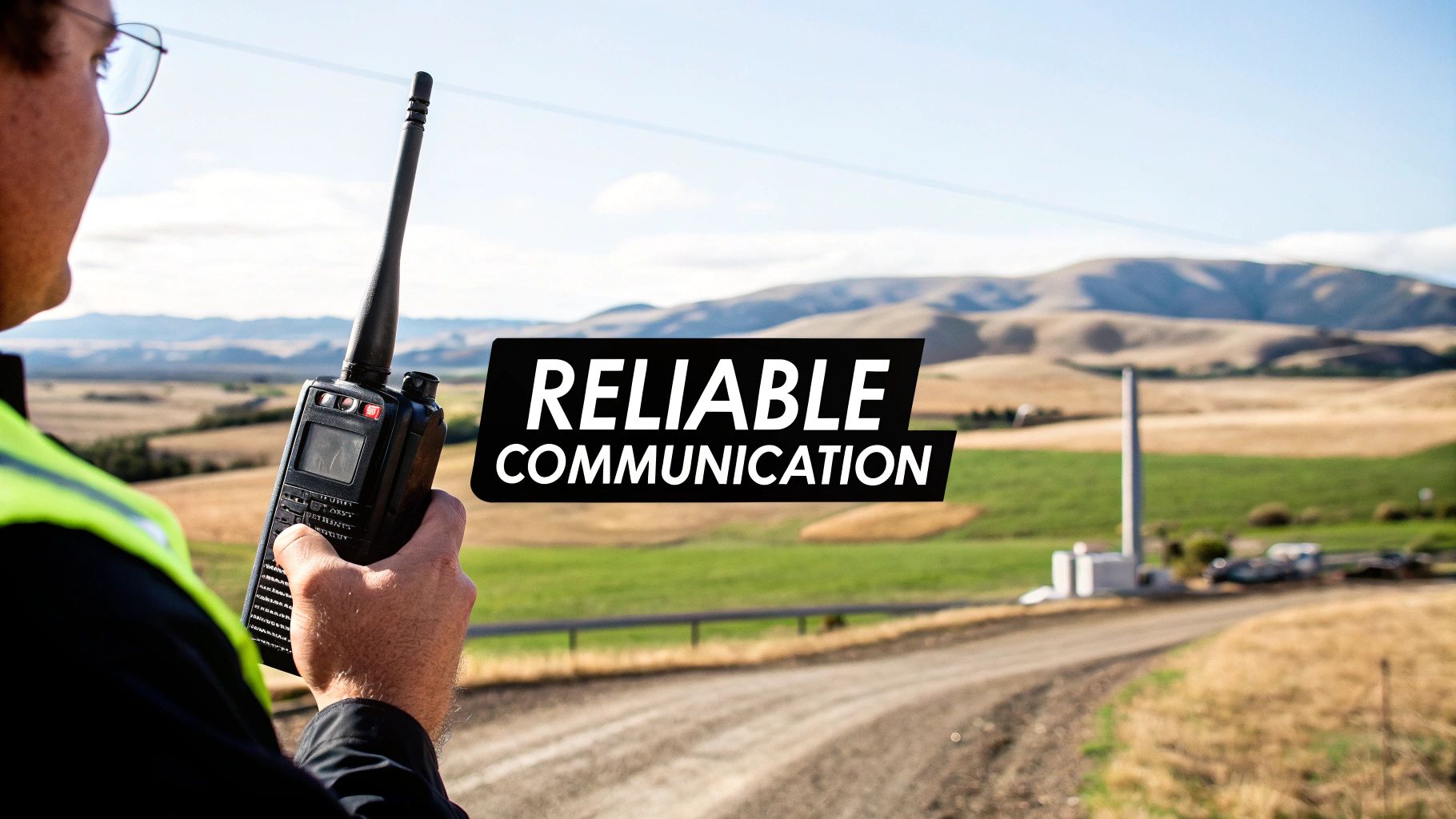Tait Communications: Your Guide to Legal Radio Solutions in NZ
When you think about the bedrock of New Zealand's critical communication networks, one name stands out: Tait Communications. They are a homegrown global leader, providing the tough, reliable, and fully compliant two-way radio systems that keep Kiwi industries moving. Whether it's emergency services coordinating a crisis response or utility crews maintaining power grids in the back of beyond, Tait solves the complex challenge of staying connected when it truly matters.
A Kiwi Legacy in Global Communications
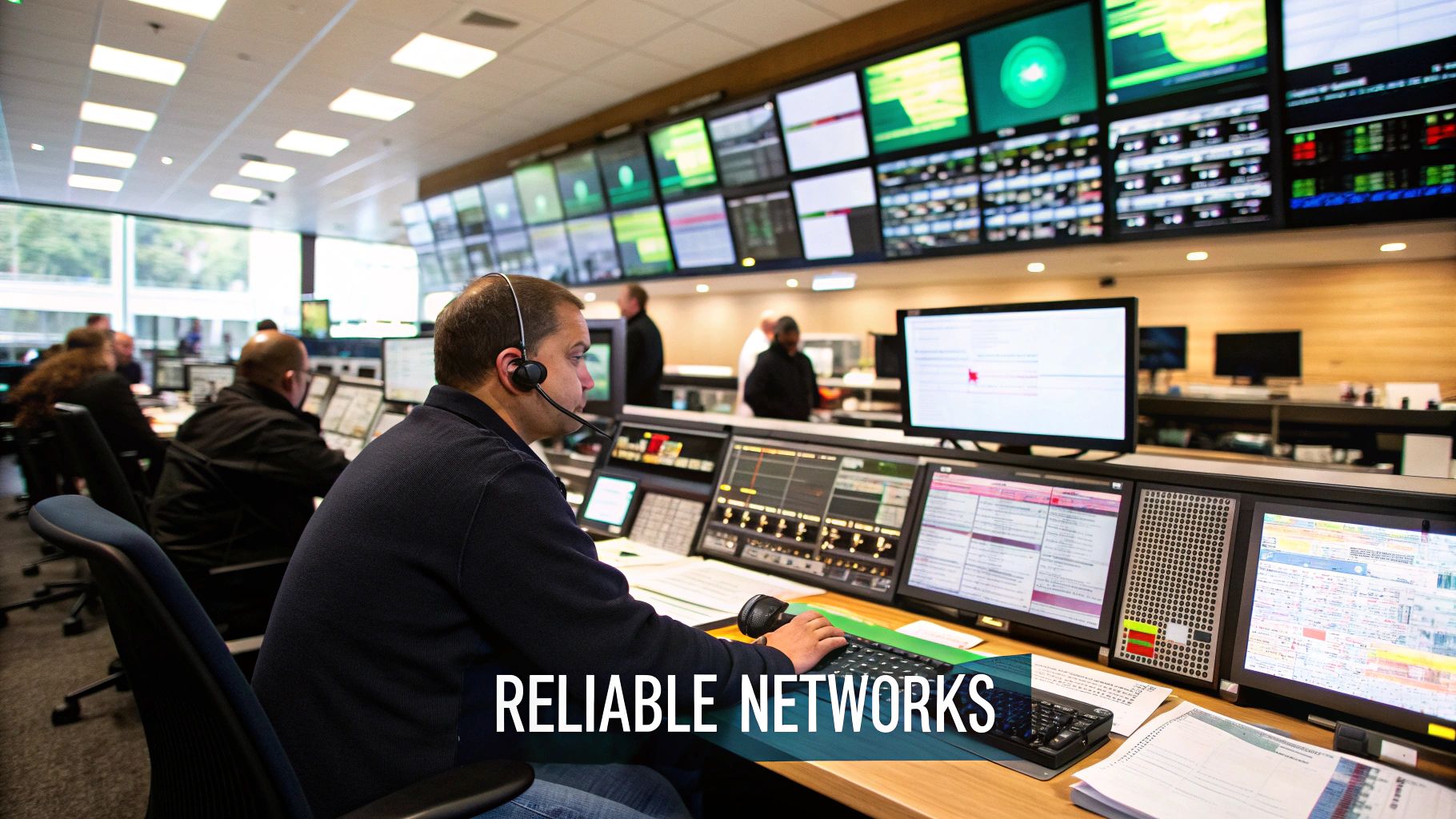
Here in New Zealand, when an organisation needs communication gear that absolutely cannot fail, Tait Communications is almost always the first port of call. They’re much more than just a manufacturer. Tait delivers complete solutions, from rugged handheld radios to sprawling digital networks that cover vast, challenging terrains where a mobile phone signal is just a distant dream.
These systems are the lifeline for many of our country's most vital sectors. They’re not just built for clear audio and durability; they’re engineered to operate within the strict legal frameworks managed by Radio Spectrum Management (RSM). This is critical, as it ensures every transmission is secure, private, and free from interference—a non-negotiable for public safety crews and large-scale industrial operations in New Zealand.
From Christchurch Roots to Industry Standard
The company's story is a cornerstone of New Zealand's tech history. Founded in 1969 by the visionary Sir Angus Tait in Christchurch, Tait Electronics Ltd. started with a team of just 12 radio technologists. They quickly made waves by pioneering New Zealand’s first all-transistor mobile radios, setting a new benchmark for innovation and reliability right from the get-go.
This dedication to quality really paid off. By the mid-1970s, their products, especially the iconic Miniphone, had captured around 70% of the New Zealand mobile radio market just a few years after its 1973 release. It’s a powerful story of local ingenuity going global.
At its heart, Tait's philosophy has always been about creating communication solutions that are truly fit for purpose. This means they aren't just technically clever; they're practical, tough, and designed with the real-world challenges of New Zealand industries front and centre.
That legacy is alive and well today. When you choose a Tait system, you're not just buying hardware. You're investing in a complete communication ecosystem built for performance and longevity. This includes:
- Custom Network Design: Getting coverage that perfectly matches your operational footprint, no matter how remote.
- Ongoing Support and Maintenance: Ensuring your system stays dependable for its entire lifespan.
- Regulatory Compliance: Expert guidance on securing the necessary radio licences for legal, interference-free operation in New Zealand.
This all-in-one approach is why partnering with a provider like Mobile Systems is so important. As you'll find when you welcome Tait Communications into your operations, having that expert support on your side ensures you get the most out of these powerful systems, keeping your team connected, safe, and productive.
The Legacy and Engineering Behind Tait Tough
To really get what makes Tait Communications different, you have to understand their core philosophy: ‘Tait Tough’. This isn't just a slick marketing slogan; it’s an engineering principle that runs deep, born from the incredible resilience of the company's founder, Sir Angus Tait. His personal history is practically woven into the DNA of the company, forging an unshakeable commitment to building gear that performs under the most intense pressure.
This philosophy guides every single design choice, making sure that each device is more than just tech—it's a lifeline.
It all started with Sir Angus Tait’s own strength and leadership, which became the bedrock of the company's culture. After coming back from WWII, where he served as a radar instructor, Angus started designing radios in Christchurch. That small operation grew into the global name we know today.
The company's reputation for sheer durability is a mirror of the challenges Angus himself overcame. He famously survived the 1968 Wahine ferry disaster, one of New Zealand’s worst maritime tragedies. That kind of resilience is exactly what defines the company’s approach to engineering. You can dive deeper into this influential story and see how it shaped the brand on the Tait Communications historical timeline.
Forged in Christchurch, Built for the World
The company's roots in Christchurch are crucial. It's where the research, development, and manufacturing all happen, turning that ‘Tait Tough’ idea into real-world, reliable products. Every single radio that comes out of the factory is a direct product of this legacy, built to meet—and beat—international standards for durability.
This snapshot from their archives shows the early days of innovation at Tait.
The image really drives home the commitment to hands-on engineering and quality control that’s still central to how they do things. It's that kind of obsessive attention to detail that you can feel in the final product.
So, what does this mean for someone using their gear on the ground here in New Zealand? It means having total confidence that your comms line will hold, no matter what the world throws at you.
The core promise of Tait Tough is simple: when everything else fails, your radio won't. This principle is tested against military standards and real-world scenarios to guarantee performance.
This commitment shows up in devices that can handle pretty much anything. We’re talking about:
- Extreme Drops: Built to survive falls onto solid concrete, a daily reality on construction sites or in busy factories.
- Water Ingress: High IP ratings mean these radios can take heavy rain, splashes, and even being fully submerged—critical for marine and outdoor work.
- Dust and Debris: The casings are sealed tight to stop fine particles from getting inside and messing with the electronics, which is essential for industries like farming and mining.
This focus on physical resilience is what really sets Tait apart. It’s the assurance that whether you’re coordinating an emergency response or managing a remote forestry crew, your connection is solid. The engineering isn't just about ticking a box on a spec sheet; it's about honouring a legacy of survival and absolute dependability.
Exploring Tait Radio and Network Solutions in NZ
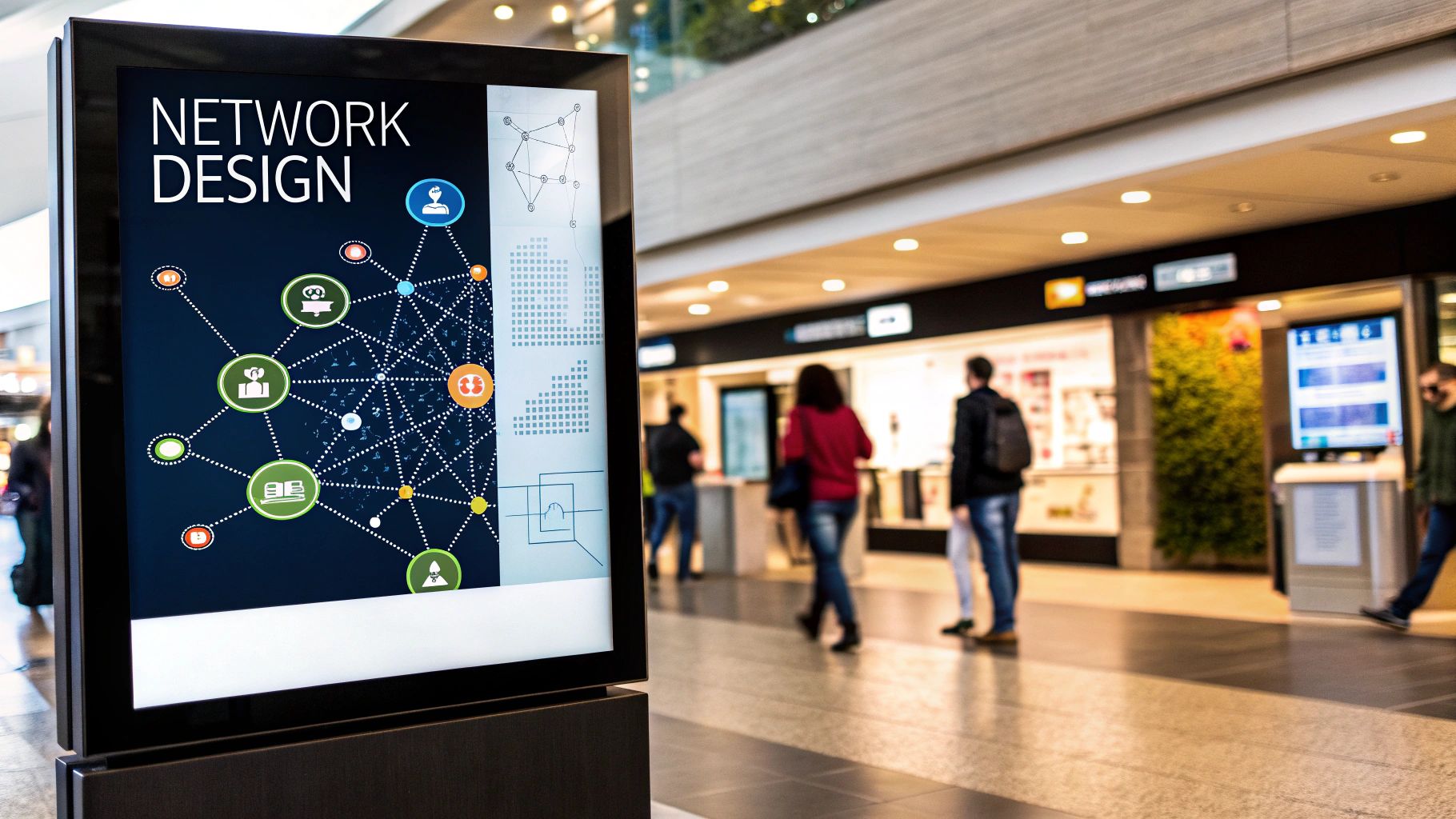
Alright, we've talked about the company's roots. Now let's get into the gear itself—the actual hardware and networks that make Tait Communications a go-to name in New Zealand. At its heart, Tait’s offerings break down into two key parts: the tough, physical radios you hold in your hand, and the clever digital networks that make them all talk to each other. Get this combination right, and every message gets through loud, clear, and secure.
The most recognisable piece of the puzzle is, of course, the radio. These aren't your standard walkie-talkies; they're the daily workhorses for critical communications in industries from civil construction to transport and logistics. A great example commonly found in New Zealand is the popular Tait TP9000 series, which you’ll find in both handheld (portable) and vehicle-mounted (mobile) versions on sites all over the country.
But what makes them more than just a button and an antenna? It’s the features designed specifically for the tough realities of a worksite.
Turning Tech Specs into Real-World Wins
It’s easy to get bogged down in a spec sheet full of acronyms and numbers. What really counts is what those specs mean when you’re out in the field, under pressure. An IP (Ingress Protection) rating, for example, isn’t just a technical detail. It’s what keeps your radio working after a sudden downpour on a building site, instead of failing right when you need it most.
The same goes for battery life. Tait’s emphasis on long-lasting power isn’t just for convenience—it’s a direct boost to safety and productivity. It means a worker’s radio can run for their entire shift without a single recharge. For anyone working in a remote or hazardous area, that constant, reliable link back to the team is absolutely non-negotiable.
A radio is only as good as its ability to function when you need it most. Tait's design philosophy translates technical excellence into practical reliability, providing a lifeline that holds up under pressure.
This real-world focus is crystal clear in their built-in safety features. For staff who work by themselves, functions like Man Down and Lone Worker are game-changers. Man Down can automatically send an alert if the radio's sensor detects a fall. Lone Worker acts as a digital check-in, requiring the user to respond at set times—if they don't, an alarm is triggered. For managers and staff alike, these features provide a vital safety net and incredible peace of mind.
To give you a clearer picture of how Tait's products fit into different operational needs, here's a quick overview of their main solution categories commonly available for Kiwi businesses.
Tait Communications Product Solutions Overview
| Solution Category | Primary Use Case | Key Features | Example Industries in NZ |
|---|---|---|---|
| Portable Radios (e.g., TP9000) | On-the-ground team communication | Rugged, ergonomic design; long battery life; advanced safety features like Man Down & Lone Worker; clear audio. | Construction, Security, Events Management, Forestry |
| Mobile Radios (e.g., TM9000) | Vehicle-based communication and dispatch | High power for extended range; GPS integration for fleet tracking; seamless network roaming. | Transport & Logistics, Public Transport, Emergency Services, Utilities |
| DMR Network Infrastructure | Creating wide-area communication coverage | Scalable from single-site to nationwide coverage; secure, encrypted voice and data; enhanced call management. | Utilities (Power, Water), Local Government, Airports |
| Unified Critical Communications | Integrating radio, cellular, and broadband | Connects radio users with teams on smartphones or PCs; interoperability between different networks. | Public Safety, Large Enterprise, Transportation Hubs |
As the table shows, it's not just about the individual radio but how it fits into a larger system designed for a specific job—from a single construction site to a nationwide logistics fleet.
The Brains of the Operation: Digital Mobile Radio (DMR) Networks
While the handsets are the tools you see and use, the network is the invisible intelligence connecting everything. Tait is a specialist in Digital Mobile Radio (DMR) networks, which are a massive leap forward from old-school analogue systems.
Think of it like the jump from a crackly AM radio station to crystal-clear digital audio. The improvement in clarity is huge, but DMR also brings major benefits in security and overall capability.
This DMR backbone is what enables all the advanced features and provides coverage across sprawling sites or even entire regions. It ensures your communications are not just clear, but private and encrypted. Ultimately, the right setup comes down to your unique operational needs. Whether you’re managing a fleet of trucks across the North Island or a construction crew on a single city block, there’s a Tait radio and network solution built for the task.
Understanding Tait DMR and P25 Network Technology
So, how does Tait Communications pull off such seamless, large-scale communication? The secret is in their network technology. Let's break down the two key platforms you'll find in New Zealand: DMR and P25.
Making the jump from old analogue radio to modern digital is like switching from a crackly AM broadcast to crystal-clear digital audio. It’s a massive leap in quality, security, and sheer efficiency. This is where Tait really shines, building robust digital networks that make sure every single message gets through, loud and clear.
DMR Tiers: The Multi-Lane Motorway for Business
Digital Mobile Radio (DMR) is an open standard that has become the absolute workhorse for commercial industries all over New Zealand. It’s structured in 'Tiers', with each one adding more power and capability.
-
DMR Tier 2 (Conventional): Think of this as having several private, two-way conversations happening all at once on their own dedicated channels. It’s a perfect fit for organisations that need reliable group communication across a single worksite or a local area.
-
DMR Tier 3 (Trunked): Now this is the smart, multi-lane motorway of radio networks. Instead of locking you into a fixed channel, a Tier 3 system is intelligent. It automatically finds a clear path for every single call. For large, bustling operations like ports or city-wide transport fleets, this "trunking" technology is a game-changer. It stops congestion in its tracks and guarantees a line is always open when you need it. A great example of a radio built for this environment is the Tait TP9355 DMR portable radio, which is designed to squeeze every bit of performance out of these advanced networks.
P25: The Gold Standard for Public Safety
While DMR is the go-to for the commercial world, Project 25 (P25) is the mandated standard for New Zealand's public safety agencies. It was created to solve one massive problem: making sure different emergency services can actually talk to each other when it counts.
P25 guarantees interoperability. This means police, fire, and ambulance services can all communicate on a shared network during a major incident. For a coordinated emergency response, this isn't a nice-to-have; it's a non-negotiable requirement.
When you're dealing with critical communications, you have to enhance communication network security, and that's a principle baked deep into Tait's technology. Both DMR and P25 platforms use powerful encryption to shield sensitive information from eavesdroppers—a vital feature for public safety and private enterprise alike.
This infographic shows just how Tait's reliable networks deliver real, tangible results across different sectors.
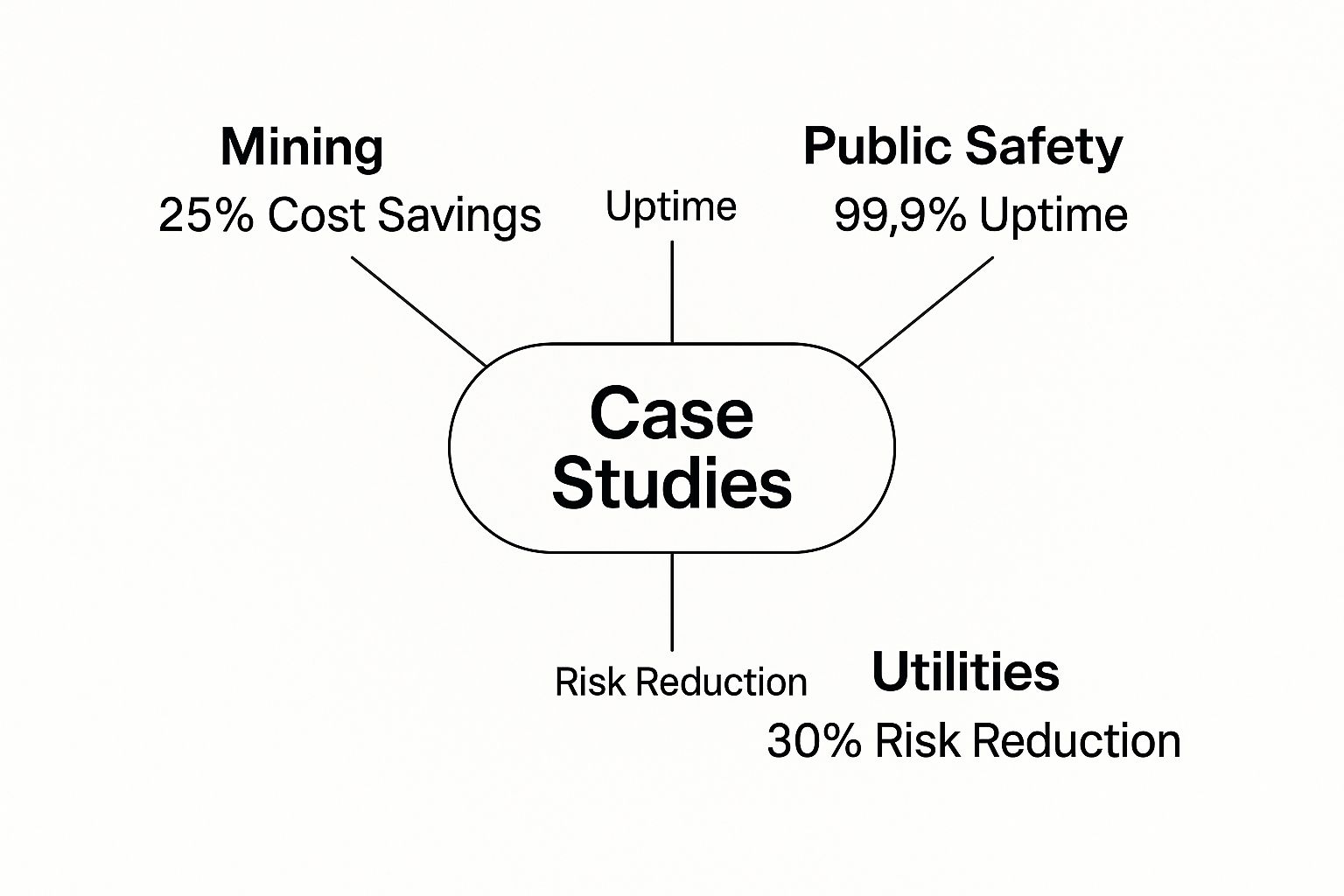
The numbers speak for themselves. Investing in a solid Tait network translates directly into better safety, slicker operations, and serious cost savings. Whether it's DMR for your business or P25 for public safety, these networks deliver total coverage, ensure your teams can work together, and are built to grow right alongside your organisation.
How New Zealand Industries Rely on Tait
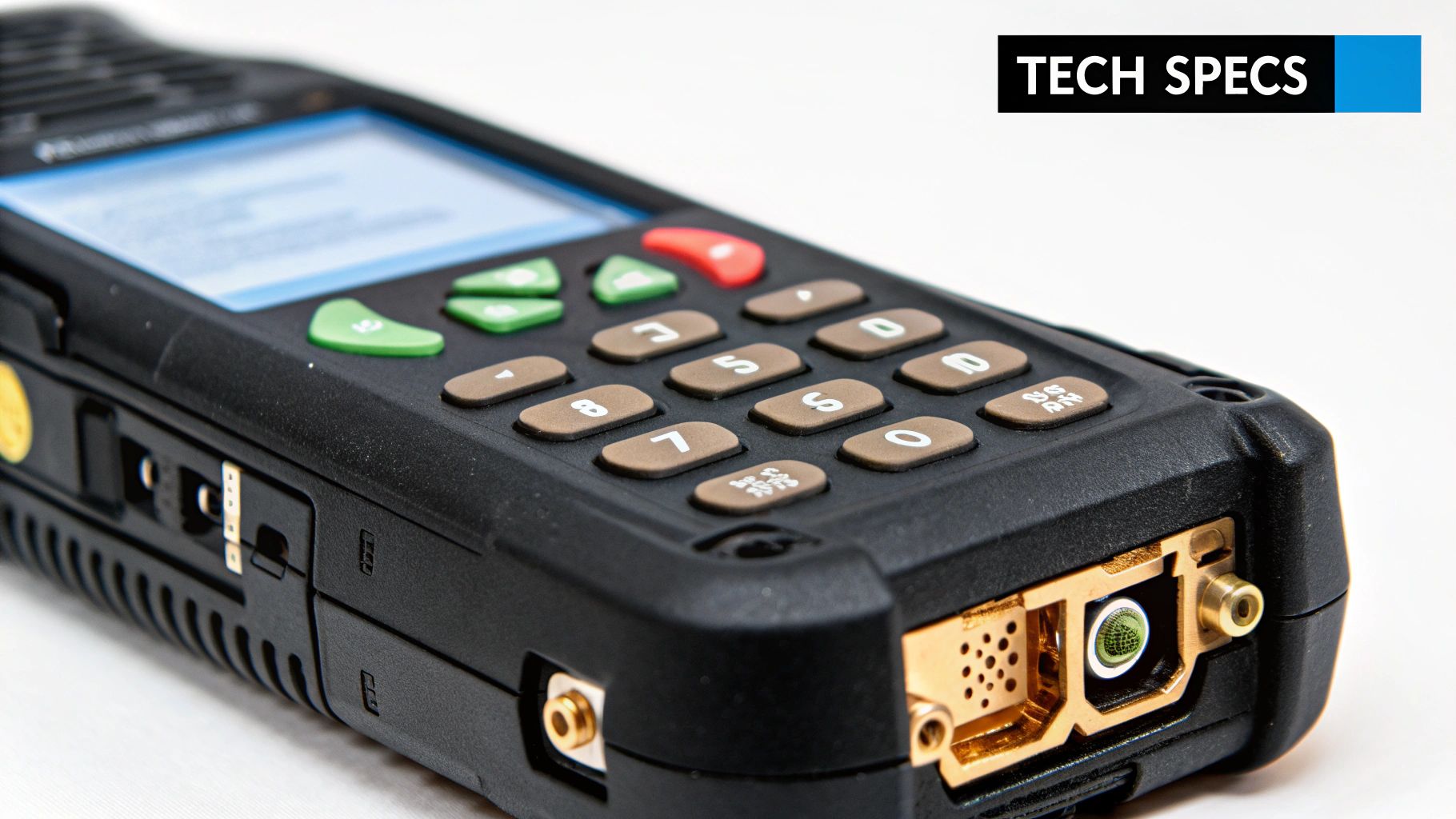
The true measure of Tait Communications technology isn’t found in a spec sheet—it’s out in the real world, solving daily, high-stakes challenges across New Zealand’s key industries. This is where rugged design and smart network engineering really shine. From the dense forests of the South Island to the busy streets of Auckland, Tait provides a lifeline where a standard mobile phone simply won’t cut it.
Picture a forestry crew working deep in a remote plantation, miles from the nearest cell tower. Their Tait radios are more than just tools for coordinating the job; they are their only link to safety. If an accident happens or the weather turns unexpectedly, that clear, instant push-to-talk connection is what separates a minor hiccup from a serious emergency. That's the 'Tait Tough' promise in action.
Public Safety and Emergency Response
For New Zealand's first responders, reliable communication is literally a matter of life and death. During major events, police, fire, and ambulance services depend on their P25 networks to coordinate without a hitch. Tait systems are engineered to perform under the immense pressure of a crisis, making sure different agencies can talk to each other without interference or dropped calls.
This interoperability is absolutely crucial. It means a fire crew can pass vital information directly to an incoming ambulance team, or police can manage a multi-agency response with total clarity. The security built into these networks also shields sensitive operational details—a non-negotiable for public safety work.
Utilities and Infrastructure
Keeping New Zealand’s power grids and water supplies running often means sending crews to isolated and hard-to-reach spots. For these utility companies, Tait Communications provides the communication backbone needed to manage these scattered teams safely and efficiently. A linesman fixing a fault in a rural valley can stay in constant touch with the central control room, giving status updates and getting instructions.
In industries where worker safety and keeping the lights on are top priorities, communication failure is simply not an option. Tait networks deliver the resilience needed to keep critical infrastructure going and field crews safe, no matter the location or conditions.
Features like GPS tracking, built right into Tait mobile radios, let dispatchers see exactly where their teams are on a map. This helps them send the closest crew to a new job, cut down on travel time, and adds a huge layer of safety, as a worker’s location is always known. This is where a powerful device like the Tait TP9361 DMR VHF portable radio proves its worth, blending a tough-as-nails build with advanced network features.
Transport, Construction and Logistics
In the fast-paced worlds of transport and construction, efficiency is the name of the game. Think of a logistics company in Auckland using a Tait DMR network to manage its fleet of delivery trucks. Real-time GPS tracking lets them optimise routes on the fly, helping drivers dodge traffic and hit tight deadlines.
Over on a large construction site, coordination is everything—for both safety and productivity. Tait radios connect crane operators with ground crews and site managers, ensuring everyone is on the same page. This prevents expensive mistakes and, more importantly, slashes the risk of accidents in a high-hazard environment.
These real-world examples show that Tait is far more than just hardware. It’s a complete communication solution that directly boosts safety, drives efficiency, and underpins the success of the Kiwi industries that form the backbone of our country.
Answering Your Questions About Tait Radio Systems
When you're looking into professional two-way radios, a lot of questions can pop up. It's completely normal. You're trying to figure out what's legal, what's reliable, and what all the technical jargon actually means for your team on the ground. Let’s clear up some of the most common queries about Tait Communications gear in New Zealand, so you can make a confident choice for your organisation.
Are Tait Radios Legal to Use Anywhere in New Zealand?
Yes, they are, but there's a critical step involved. Because Tait radios are professional-grade, they operate on specific, licensed radio frequencies. To use them legally in New Zealand, your organisation needs a radio licence from Radio Spectrum Management (RSM). A certified Tait provider can walk you through this entire process.
Getting a licence is what makes sure your conversations are private, secure, and don't accidentally cut across other users' channels—especially crucial emergency services. It's what transforms a powerful radio into a legally protected communication tool for your business.
Think of a radio licence like having your own private lane on a motorway. It's reserved just for your team, giving you a clear, uninterrupted path for your vital communications, free from anyone else's traffic.
This managed approach to the airwaves is exactly how reliable, professional communication is maintained across the country.
What Makes Tait a Better Choice Than Cheaper Brands?
It really boils down to two things: rock-solid reliability and long-term support you can count on. The 'Tait Tough' promise isn't just a marketing slogan; it's a design philosophy. Their radios are built from the ground up to survive the tough-as-nails industrial environments where cheaper, consumer-grade radios would give up the ghost in no time. We're talking about surviving drops, dust, and water—everyday hazards on a Kiwi worksite.
Beyond just the hardware, Tait Communications provides complete network solutions and has a strong local support network in New Zealand. This means your critical comms system will stay dependable for years to come. You're not just buying a radio; you're investing in the safety and operational continuity of your business.
What Is the Difference Between DMR and P25?
Both are digital radio standards, but they’re built for different crowds.
- DMR (Digital Mobile Radio) is an open standard that’s become incredibly popular in commercial industries. Think transport, utilities, and construction. It's known for being flexible and easy to scale up as a business grows.
- P25 (Project 25) is a specialised standard developed specifically for public safety organisations like police, fire, and ambulance services. Its main job is to ensure different agencies can talk to each other flawlessly during a major emergency.
Tait is a world leader in delivering powerful solutions for both standards, perfectly matching the unique demands of commercial and public safety users right here in New Zealand.
Can Tait Radios Work Without a Network?
Absolutely. Tait portable radios can communicate directly with each other in what’s often called 'direct mode' or 'talkaround'. This is incredibly handy for small teams working close together, like a maintenance crew on one floor of a building or a small event team in a park.
But, if you need to cover a wider area, link up separate teams, or use advanced features like GPS tracking and central dispatch, you'll need a network. This infrastructure, built around devices called repeaters (like in a DMR Tier 2 or Tier 3 system), is what expands your communication footprint from a small, localised bubble to a massive worksite or even an entire region.
For expert advice on designing, licensing, and deploying a Tait Communications system that’s perfectly suited to your needs, trust the specialists at Mobile Systems Limited. We make sure you get a reliable, durable, and legally compliant solution that keeps your team connected when it matters most. Learn more about our communication solutions.


